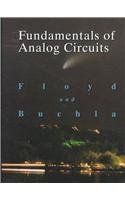
Synopsis
A textbook introducing discrete linear devices and circuits and describing operational amplifiers and other linear integrated circuits. One feature is that the circuit diagrams indicate current with a polarized meter symbol rather than arrows, both to reflect the readings from an ammeter and to specify the relative current magnitude. Radio-frequency amplifiers and transducers are also considered. Solutions to some of the end-of-section exercises are provided at the end of each chapter. The glossary does not indicate pronunciation. No bibliography. Annotation c. by Book News, Inc., Portland, Or.
"synopsis" may belong to another edition of this title.
From the Back Cover
Fundamentals of Analog Circuits offers comprehensive coverage of a wide, relevant array of topics. It integrates theory, practical circuits, and troubleshooting concepts, keeping mathematical details to a minimum. Delving more deeply into coverage of linear integrated circuits than discrete device circuits, the text guides readers through a system of pedagogical tools that both reinforces and challenges their understanding.
"About this title" may belong to another edition of this title.
Other Popular Editions of the Same Title
Search results for Fundamentals of Analog Circuits
Fundamentals of Analog Circuits
Seller: Better World Books, Mishawaka, IN, U.S.A.
Condition: Good. 1st Edition. Used book that is in clean, average condition without any missing pages. Seller Inventory # 292344-6
Fundamentals of Analog Circuits
Seller: HPB-Red, Dallas, TX, U.S.A.
Hardcover. Condition: Good. Connecting readers with great books since 1972! Used textbooks may not include companion materials such as access codes, etc. May have some wear or writing/highlighting. We ship orders daily and Customer Service is our top priority! Seller Inventory # S_347386321
Fundamentals of Analog Circuits
Seller: Phatpocket Limited, Waltham Abbey, HERTS, United Kingdom
Condition: Acceptable. Used - Acceptable. Your purchase helps support Sri Lankan Children's Charity 'The Rainbow Centre'. Ex-library with wear and barcode page may have been removed. Our donations to The Rainbow Centre have helped provide an education and a safe haven to hundreds of children who live in appalling conditions. Seller Inventory # Z1-N-007-00514
Buy Used
Quantity: 1 available
Fundamentals of Analog Circuits
Seller: Phatpocket Limited, Waltham Abbey, HERTS, United Kingdom
Condition: Good. Your purchase helps support Sri Lankan Children's Charity 'The Rainbow Centre'. Ex-library, so some stamps and wear, but in good overall condition. Our donations to The Rainbow Centre have helped provide an education and a safe haven to hundreds of children who live in appalling conditions. Seller Inventory # Z1-N-003-00566
Buy Used
Quantity: 1 available
Fundamentals of Analog Circuits
Seller: Anybook.com, Lincoln, United Kingdom
Condition: Fair. This is an ex-library book and may have the usual library/used-book markings inside.This book has hardback covers. In fair condition, suitable as a study copy. Please note the Image in this listing is a stock photo and may not match the covers of the actual item,1950grams, ISBN:9780138369330. Seller Inventory # 9314325
Buy Used
Quantity: 1 available
Fundamentals of Analog Circuits
Seller: BOOKWEST, Phoenix, AZ, U.S.A.
Hardcover. Condition: New. 1st Edition. SHIPPED FROM USA. Seller Inventory # DOM-100D1-B1-013836933X-HC-4-lb-blk
Fundamentals of Analog Circuits
Seller: The Book Spot, Sioux Falls, MN, U.S.A.
Hardcover. Condition: New. Seller Inventory # Abebooks554331

